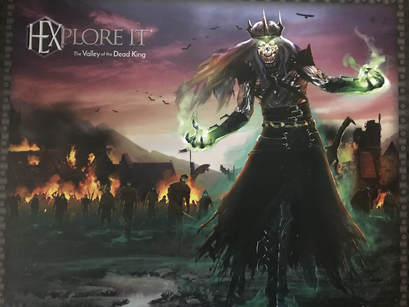 Full disclosure: I was provided a review copy of HEXplore It: The Valley of the Dead King, as well as a second copy to share with someone else via a giveaway. Click here to enter between now and April 30, 2018! To see a "How to Solo" video for HEXplore It, click here. What is this game about? HEXplore It: The Valley of the Dead King is an open world exploration game in which you play a hero or group of heroes on a quest to defeat the Dead King, an evil undead overlord who wants to replace the thriving cities of the valley with centers of death and decay. To defeat him, you must power up your character to the point where you are able to defeat him—something you can accomplish in a number of ways. Completing quests and defeating monster and boss encounters can give you both gold and power-up cards, which boost your character's stats. You can also use your gold to purchase both useful items and gear upgrades—which actually amount to stat boosts! To create your hero, you choose a race and a role. And there are a lot to choose from—almost too many if you are inclined to analysis paralysis. The different races and roles mix together to create impressively different play experiences. This is not so much a result of your starting stats, which can be improved through gear upgrades and power up cards. Instead, your characters will feel unique because they will have distinct racial abilities and mastery abilities, which are special skills associated with their role. One of HEXplore It's most distinctive features is probably its use of dry erase player boards and markers to keep track of stats. I thought that was very efficient and a lot of fun! You have a lot of freedom to wander the map and increase your heroes' power in any way you like. There is no one way to victory—in a lot of ways, the key to success is flexibility. How does it play solo? HEXplore It is a cooperative game that can accommodate 1–7 players. You are entirely able to play the game as a single hero. Or, if you want to see how well different characters work together, it is also easy to play two. I was very pleased with how the game scaled for a solo experience. 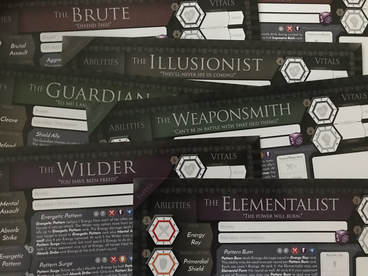 So many choices! So many choices! Overall Thoughts HEXplore It is a very good game. I loved the feeling of increasing power and capability as my character progressed, and a lot of the quest and circumstance cards have just a touch of humor that makes the game seem more alive. It's also a ton of fun to experiment with different types of characters. You can play your classic RPG Berserker, but you can also play a Beastmaster who tames creatures you encounter in the wild and deploys them in battle. One character is an Illusionist who can avoid attack by becoming invisible, and you can also play as a magician who saps the energy of opponents to weaken them. Even though the general plotline of this game is the same every time, the way you get to your goal can look entirely different, and that is tremendously satisfying. One of the keys to enjoying HEXplore It is to accept that you simply will not be able to do everything in the game. Once the Dead King appears on the board, you are on a pretty tight timer, and you are going to leave a lot undone when you finish the game. This isn't an RPG grind fest—this is a game about powering up as quickly as possible so that you can defeat an overwhelmingly powerful enemy. That said, HEXplore It sometimes groans under the weight of so many options. My games occasionally stalled out when I had too many quests that were located on undiscovered map tiles. You can explore additional tiles by purchasing a map or moving past the edge of the current game setup, but they are drawn randomly and there is no way to guarantee that you will get a specific map tile—even if it means several of your quests can't be completed. The same issue can happen with the Circumstance cards. When you move further than one tile, you need to deal with a Circumstance card. Sometimes these cards actually benefit you—the combat encounters in that deck give you rewards and power ups that are crucial for your character's growth. But a lot of Circumstance cards are just unpleasant evens or afflictions, and if you end up with too many of those, you are going to have a much less productive adventure. One possible solution to this issue is to go ahead and lay out all of the tiles at the beginning of the game—go ahead and create a huge open world, and possibly increase your max movement from 4 to 6. In all honesty, this change does not impact the difficulty of the game at all, and it eliminates some frustration by making the world more accessible. Regardless of any adjustments, however, I think that HEXplore It would benefit from being just a little bit tighter. I spent a lot of time wandering around, when I would actually have enjoyed more questing, more story—a lot of the flavor text in this game is really promising, and the world seems like it has a really cool backstory. I'd like to enjoy the valley just a bit more, because I want to know why it's so important to save it from the Dead King, aside from the fact that undead kings are inherently creepy. All in all, HEXplore It has a few issues with game flow, but it's exciting and enjoyable. I also hugely respect what Jonathan Mariucci has done in terms of building characters and presenting players with different combat strategies to try. Do I recommend it? Yes. If you love fantasy themes, leveling up, and working with different character abilities, you are really going to enjoy HEXplore It: Valley of the Dead King. Overall Rating: 3.5 stars Rating Scale: 5 stars — I love it! 4 stars — I really like it. 3 stars — I like it. 2 stars — It's okay. 1 star — Meh.
2 Comments
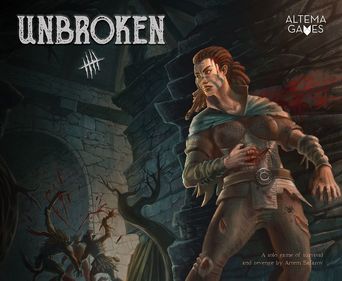 Today I am doing something new for this site: a Kickstarter preview! I have never done one before, but I am very pleased to present Unbroken, a solo dungeon adventure designed by Artem Safarov and published by Altema Games. To see the campaign page, click here. Artem kindly provided me with a print and play version of Unbroken so that I could test out the game and write this preview. What is Unbroken about? In Unbroken, you are a hero who boldly ventured into a dungeon with the rest of your party... only to have things end very badly. Now, you're the sole survivor, and you've woken up in the depths of the dungeon with only your wits to aid you in your quest for vengeance and escape. If you ever want to see the light of day again—as well as give the monsters who killed your friends a taste of their own medicine—you'll need to gather resources, conserve your energy, and conquer four terrifying dungeon bosses. The trick to Unbroken is the careful management of resources. You only have so much effort to expend on fighting or preparing to fight. On each level, you have a limited amount of time to spend before you confront each monster, and you need to use it as wisely as possible. During each turn, you complete an explore phase in which you gather the materials you need to progress. Will you scout ahead to see what monster you're facing, or will you boldly face the unknown? Will you hunt for metal and wood so that you can build weapons? Will you rest and conserve energy? The choices are yours, and while there is some luck involved when it comes to which cards you draw while exploring, your decisions have a significant impact on the outcome of your game. When the time you have to complete each level dwindles, it's time to face the boss. Once again, you have choices: Will you push your luck and risk being ambushed by a monster? Or will you call time early and go on the offensive? If the latter, will you fight the boss and hopefully reap rewards for doing so? Or will you pay a smaller up front cost to sneak by and progress to the next level without taking too much damage? (The fourth and final boss will be tough and can only be defeated by fighting, so you need to prepare!) All of these factors combine to create a highly engaging solo game that offers a challenge without taking too long to play. If you enjoy solo games, fantasy themes, and doing your best to come up with a plan of attack against a monster, you are going to like Unbroken. 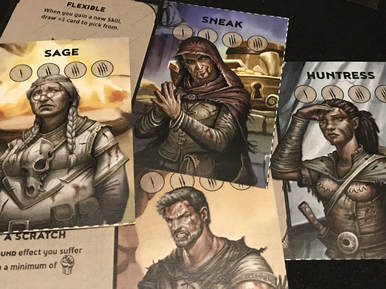 I'm a big fan of the character art in this game. I'm a big fan of the character art in this game. What I like about Unbroken I think Unbroken has a lot to offer solo gamers. The base game already has a lot of replayability, and I think it will keep me interested for a long time. The monsters you fight on each level are chosen at random via a die roll, so your game will play out differently every time. Each monster has different attacks, strengths, and weaknesses, so it's crucial to adjust your strategy for each upcoming fight. It's not just about getting the most powerful weapon upgrade, either—it's about making sure you've acquired the best possible configuration of resources and skills. If there are expansions for this game, then the replayability will become even greater—and I think this game has the potential to get some really good expansions. I also like that there is more of an element of choice than you'd find in your typical dice chucker. Although you draw cards during the explore phase, which means you may not find the things you really want, you still have a lot of say when it comes to how your character develops. This especially becomes the case when you draw skill cards after a battle—the way you choose to customize your character plays a large role in the strategies you choose as you prepare for the final confrontation. The theme of Unbroken also amuses me. I love that as you try to escape the dungeon, you encounter this entire society of creatures who live there and have their own economy and ecosystem. Sure, there are terrifying boss monsters, but there are also mushrooms to harvest and creatures to trade with. I find that very appealing, and would actually like to see that aspect of the game get more attention. (And it looks like it will, since several boss monster backstories have been unlocked since the start of the campaign!) Possible Concerns about Unbroken My main concern about Unbroken is that, at some points, it can be finicky. During my test plays, my biggest challenge came from remembering to do things in just the right order. You can only use your skills at certain times, and you have to remember to reset the number of available skill uses at the beginning of each level. Before a boss fight, you need to remember to adjust the time tracker before you start, even though you haven't technically progressed to the next level yet. These are small points, but they can really break your immersion. I am hoping to see clear, bulleted player aids in the rulebook when the final version is made, because I think it would really help. Should I back it? I think that Unbroken is definitely worth backing. In fact, I am backing it myself. It offers a unique twist on a dungeon crawl, both thematically and in terms of gameplay mechanics. It's also just good fun, and a game that keeps me engaged for the entire time I'm playing it. I look forward to writing a full review when the final version of Unbroken is published. Unless something really weird happens, it's going to be a positive one. If you'd like to see more, check out my playthough of Unbroken on YouTube. It should give you a good sense of how the game flows:  This week is the week of small yet enticing board games. At the moment, there are several quick and charming games that look like they would be quite enjoyable solo. Plus, the price is right—all of these campaigns offer a game for under $25, including shipping. 1. Fire in the Library Fire in the Library is a charming filler game that happens to be about my worst nightmare—a library in flames. Your job is to rescue as many books from the fire as possible, both to score points and to be a decent human being. This game has fun push-your-luck mechanics, in that the more you push when trying to rescue books on your turn, the more the fire can spread. You also have to make decisions about how and when to use tools to mitigate the fire. When will you push your luck? Which books will you ultimately save? Also, the solo mode will involve competition against AI players, which means that one-player games will be a bit more robust than the typical beat-your-own-score affair. 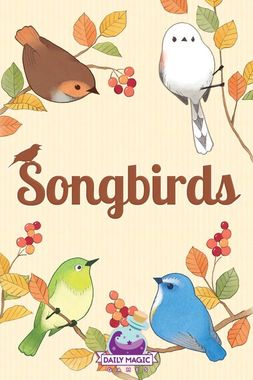 2. Songbirds They say that the early bird gets the worm. But in Songbirds, the loudest birds get the berries. In this beautifully illustrated card game, you are a forest spirit who prefers a particular color of songbird—and who will try to stack rows and columns with high-scoring birds of your preferred color to ensure that your beloved birdies are well fed. This game looks quick, simple, and charming—but also strategic enough to provide a challenge. The solo variant of this game involves a beat-your-high-score race for victory points, but I think it looks like a relaxing way to spend a few minutes on a busy evening.  3. Cat Rescue If hungry little birds weren't enough for you, then there is also Cat Rescue. This game is a cooperative effort to save and adopt adorable shelter cats. The draw deck represents cats you are pulling in from the street, and your "shelter" is a 4x4 grid on the game table. You can make cats eligible for adoption by arranging the grid to create rows or columns of matching cat cards. The game ends either when you empty the draw deck or when one foster home is overrun by more than three cats. This is another game where you are going for the most victory points, but again, it looks quick and relaxing—and really cute. 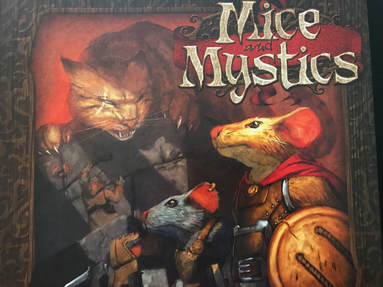 What is this game about? Mice and Mystics is a story game in which you follow the adventures of Prince Collin and his friends—humans who are currently trapped in the bodies of mice. They are trying to figure out how to rid the kingdom of Collin's wicked stepmother, and only by progressing through the tale can you find out whether they succeed. Mechanically, M&M is a light dungeon crawler in which you move miniatures around a board, roll dice, and deploy useful skills that you have acquired along the way. You also need to complete each "chapter" in a limited amount of time. Run out, and you lose the scenario and have to repeat it. When you complete a scenario, you get to read another chunk of text from the storybook to find out what happens next—and to set up the next part of the adventure. How does it play solo? Mice and Mystics is a cooperative game, which means it is definitely solo friendly. However, you will need to control four mice in a typical scenario. You will also need to operate all of the enemy characters, who move and attack according to a set of enemy rules. The game is not complex enough for this to be a major problem, but if you prefer "pure" solo games in which you play only one character, then be aware that M&M won't provide that experience. 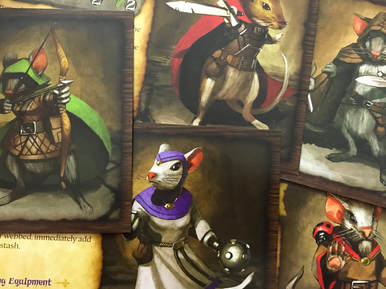 Overall Thoughts Mice and Mystics has a very charming theme, especially if you grew up loving Brian Jacques books, Watership Down, and The Secret of NIMH. This game also reminds me of Mouse Guard, and that is by no means a bad association. The story is cute, and it's fun to progress through the adventure to see what will happen next. I would not, however, say that Mice and Mystics is a great game. The mechanics are very heavily influenced by die rolls with little opportunity for mitigation. More importantly, though, combat feels very repetitive—even with different enemies, the "gameplay" parts of Mice and Mystics feel samey, and I find myself itching to get to the next part of the story. Also, while Mice and Mystics is not a difficult game to play, it is still surprisingly fiddly. I mentioned in my last post about this game that I occasionally just house rule things as I go rather than look up that one little combat detail in the rules. I hate interrupting the fun of a game over a technicality. That said, I have a tremendous emotional attachment to Mice & Mystics, and I own both expansions. It won't be leaving my collection anytime soon. This is because my boyfriend has a lot of nostalgia for stories like Watership Down, and this is one of the few games that he gets excited to play with me. When you play Mice & Mystics with another person and really get into the gameplay, the game comes alive because you're sharing the experience with someone else. I have fond memories of Mice & Mystics date nights, and that smooths over many of the game's flaws for me. Do I recommend it? For solo? No. There was a time when there were fewer options out there, and Mice & Mystics was a commonly recommended for solo. But there are so many really interesting solo dungeon crawls on the market now... I wouldn't commit to M&M specifically for the solo play. I would, however, recommend Mice & Mystics to families and also to groups with players who are either new to dungeon crawls or able to really get into a fun story. Those are the fellow players you need if you want to get the most out of this game. Overall Rating: 2 stars (3+ stars for group play, depending on your group) Rating Scale: 5 stars — I love it! 4 stars — I really like it. 3 stars — I like it. 2 stars — It's okay. 1 star — Meh. 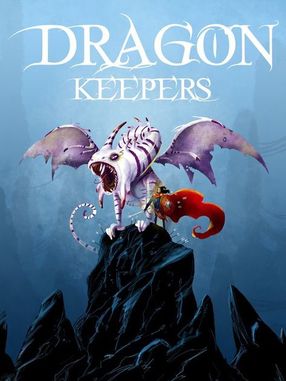 Hey gamers! We are headed into the last couple of weeks of March, and as usual, there are some great-looking solo board games to be found on Kickstarter. Let's get down to business, shall we? 1) Dragon Keepers For solo gamers who also play with their families, Dragon Keepers looks like a solid choice. This game is about dragon keepers who train dragons and protect them from evil dragon hunters. It comes with several modes of play, including a cooperative mode in which dragon keepers train their dragons to attack the hunters who want to harm them. The art has a fun, whimsical style that is cute without being overly "for kids." The game is definitely not custom built for solo, and you'd have to play by controlling multiple hands, but based on a glance at the rules it looks very doable.  2) Dinosaur Island This is as close as you can get to "Jurassic Park: The Board Game" without paying licensing fees. Dinosaur Island is a worker placement game in which you build a dinosaur park exciting enough to attract a lot of visitors... while also trying to keep those visitors safe from rampaging dinosaurs. This campaign also allows you to pledge for expansions and for Duelosaur Island, a two-player dino-themed face-off. I'm not planning to back this myself—I played a friend's copy and thought the multiplayer game was fun, but not enough for me to pledge $85 to play it solo. If the theme appeals to you, though, you should give it a look. 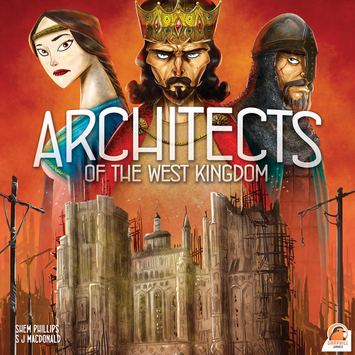 3) Architects of the West Kingdom If you enjoyed the "North Sea" trilogy--Shipwrights of the North Sea, Raiders of the North Sea, and Explorers of the North Sea--then you might enjoy this one as it is designed to be the start of the next trilogy that follows up on those games. It's a worker placement game in which you are competing for glory while building a city, and there is some choice about whether you want to progress as a fine outstanding citizen or as someone who is willing to hire thieves to get things done. There is a fully-developed AI system for solo players to compete with, as well. I'm not planning to back this one, myself, because the North Sea games are now all available in retail stores, and my Kickstarter budget is very small right now. But if you love games in this overall series and you want to get the Kickstarter exclusives, it may be worth it for you. 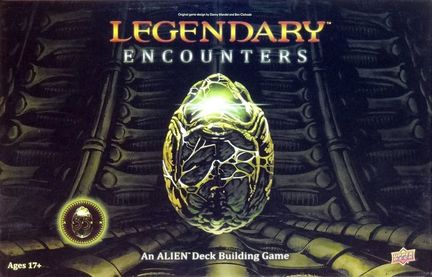 To watch a How to Solo video for this game, click here. What is this game about? Legendary Encounters: An Alien Deck Building Game is an awkwardly-named board game with an awesome theme. It's part of a larger family of Legendary deck builders, but Legendary Encounters: Alien stands on its own as a game worthy of your consideration, whether you like the Alien movies or not. Legendary Encounters: Alien is a thematic deck builder that allows you to play through all four Alien movies, encountering characters and plot points that are true to their source material. As in most deck builders, players begin with a starting deck and acquire more powerful cards as the game goes on. To win, players need to progress through three different objectives, each of which has its own mini deck. Objective cards are stacked together to form one big, nasty enemy deck. Enemies in this game are formidable and occasionally scary—especially the face huggers. Yes, there are face huggers in this game, and they could pop out at just about any time. A player who can't get rid of a face hugger quickly enough is "impregnated" and has to shuffle a chest burster into his or her deck. This is basically a death sentence, so the face huggers add enormous tension to the game. Dealing with alien encounters (see what I did there?) is even more nerve-wracking because enemy cards approach you face down. To find out what they are, you either have to scan them (and potentially have something bad happen right away) or allow them to reach the combat area and give you a nasty surprise. On the player side of things, each player chooses a role that allows him or her to make unique contributions to the game and to add a role-specific card to his or her starting deck. This is an excellent addition to standard deck building, because you start out with a cool card in your deck instead of playing only generic starter cards for the first 2–3 turns. To improve their decks, players purchase cards from a "barracks" deck. The barracks are built from smaller decks of cards that are based on characters from the Alien films. For example, there are Warrant Officer Ripley cards, Bishop cards, etc. that really add to the flavor of the game. While the movie-based scenarios tell you which character cards to put in your barracks deck, you can also choose to mix and match. During the game, players can collect cards with matching symbols that allow them to chain abilities and also to "coordinate"—play a card on another player's turn to give someone else a boost. Trying to build a strong deck as quickly as possible, and to set yourself up for success, is what makes Legendary Encounters: An Alien Deck Building Game so satisfying. 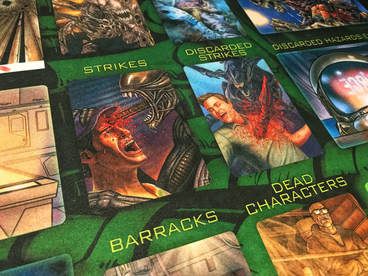 How does it play solo? While it is technically possible to play Legendary Encounters: Alien with only one character, and some people do play that way, I strongly recommend that you control two. Playing two-handed allows you to take advantage of your cards' coordination abilities, as well as to get a better balance of character skills and card symbols to work with. Also, if you have only one deck, it can really limit you if you draw a bad hand—especially when you're trying to deal with a face hugger! Legendary Encounters: Alien is interesting in the sense that it doesn't scale perfectly, and actually gets more difficult when you add more players. Enemies multiply and move every single turn, and when there are more players, no one person has many turns to bulk out his or her deck before things get messy. If you start out playing two-handed but want to ramp up the difficulty, bump yourself up to three characters. Overall Thoughts I think this game is awesome. I am a big fan of the Alien franchise, and the thematic touches in Legendary Encounters are spot on. I particularly love seeing characters and scenarios I recognize, but with original art instead of screen captures from the films. It is true that the art can be a bit uneven, but I think it helps make the game its own special experience. I also enjoy trying to chain card effects and get the most out of coordination cards. I like deck builders in general, but I particularly love games that let me get clever with card effects. My biggest quibble with Legendary Encounters, however, emerges from that same desire to set up cool combos. It can be difficult to thin out your deck and get rid of weaker starter cards. That means that sometimes you will just have blah turns and there isn't anything you can do about it. The other possible issue you might have with this game is its replayability. Don't get me wrong, there is plenty in the main box—the first four movie-based scenarios are just starting points, and frankly, I have gotten and continue to get a lot of gameplay out of them, especially when trying out different role combos. If you don't want to stick to the original movie plots, you can also do crazy mix-and-match stuff. That means you could theoretically play a game using all four versions of Ripley, one from each of the movies. You can also mix and match locations and objectives to create a different game every time. But the game still "feels" contained somehow, at least to me. I think it's because the movie-centered scenarios are the ones that make the most thematic sense, and therefore the ones I prefer to play. Fortunately, Legendary Encounters: An Alien Deck Building Game has a very good expansion that adds two new scenarios and several character cards to the game. It also introduces "hard mode" to breathe new life into all of the original scenarios. Additionally, you can do something I haven't tried yet. If you pick up Legendary Encounters: A Predator Deck Building Game, you can combine it with Alien. If you enjoyed the ridiculousness that was AvP, you might get a kick out of doing this. I am definitely curious. If you have tried this, please let us know about it in the comments! One more possible warning about Legendary Encounters: Alien: Initial card sorting for this game sucks. When you open up the box, the cards will be in no particular order. As in, almost deliberately in a crazy order just so you will have to sort it all out. You might want to read the rulebook first so you have a sense of which cards ought to go together. Also, you might want to sleeve the cards. I haven't had issues yet, but the cards don't quite feel premium to me. The game does, however, come with a neoprene mat that is awesome. Do I recommend it? Definitely. I believe that Legendary Encounters stands on its own as a quality deck building game, even if the Alien theme isn't your favorite. In my opinion, it is one of the most thematic and immersive deck building experiences on the market. It has minor imperfections, but this game grabs my attention and holds it every single time I play. Overall Rating: 4.5 stars Rating Scale: 5 stars — I love it! 4 stars — I really like it. 3 stars — I like it. 2 stars — It's okay. 1 star — Meh. 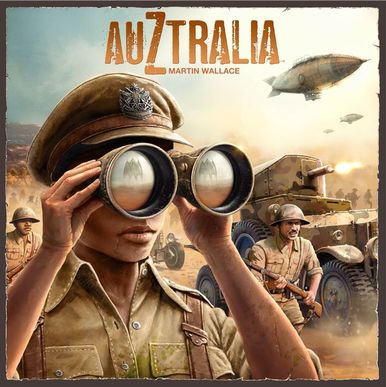 Image courtesy of BGG Image courtesy of BGG Time flies! Are we halfway through March already? I feel like I've covered most of the notable solo-playable Kickstarters that are on the market, but there are some interesting things happening at the end of March and in early April. Stay tuned! There is one big, new campaign on the scene though: Martin Wallace's AuZtralia. The game is a combination of several different phases and mechanics. Set in an alternate-universe 1930s Australia, players will spend part of the game building up their ports, railroads, and resources. Every action takes up time, and time is a limited resource—soon the Old Ones will wake up and try to destroy the player(s) and everything they've built. AuZtralia has a fully-developed solo mode and seems highly thematic. It also seems like there is a lot going on in this game. The fact that Martin Wallace is the designer, however, makes me more inclined to trust. I'll be watching this one. 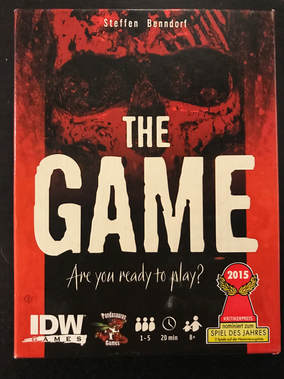 Click here to see a "How to Solo" video on YouTube! What is this game about? To be totally honest, The Game isn't really about anything. It has a vaguely threatening skull/death theme going on, but the theme has absolutely no bearing on gameplay at all. (I described the theme as "badass" when I wrote about The Game in 2016—with the quotations.) In The Game, one to five players will cooperate to lay down as many cards as possible before a someone is unable to make a legal play. You can play each card onto one of four stacks. Two start at 1 and go up to 100, and two start at 100 and go down to 1. Cards must be played in strict ascending or descending order, so if you aren't careful, you may lose your chance to play several cards in the deck. The one exception is the "backwards" rule, which allows you to play a card that is exactly ten numbers higher or lower on a stack. In other words, you can lay a card on an ascending pile that is 10 less than the top card on the pile (e.g. you can go from 57 to 47 on a 1—100 pile), or a card on a descending pile that is 10 greater than the top card on the pile (e.g. you can go from 20 to 30 on the 100 —1 pile). That's literally it. You can teach this game to anyone. How does it play solo? When you play this game cooperatively, you have imperfect information because you aren't supposed to discuss the numbers on your cards. In the solo version of the game, you lose that element of mystery/frustration, but The Game is so simple and highly engaging that it plays nicely as a solitaire card game. It also does scale for one player, so it's a breeze to solo. 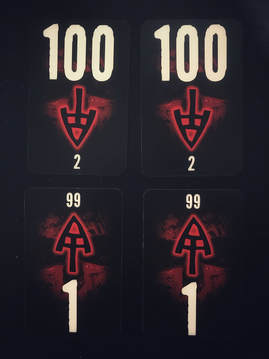 The four stacks on which you play your cards in The Game. The four stacks on which you play your cards in The Game. Overall Thoughts The Game seems like such a goofy thing to spend your time with. The name alone is absurd—trying to Google it is a huge pain, and your friends will look at you like you're crazy if you open up a conversation with "Hey guys, want to play... The Game?" (In fact, its full English name is, The Game: Are you ready to play The Game?) Its rules are almost ludicrously simple, and while you can play strategically to an extent, The Game is so luck-based that you will rarely win. You will often have games where you do terribly. In spite of that, The Game is shockingly addictive. When I do pull it out to play, I find myself playing it 3–4 times in a row without giving it a second thought. There is an app that is even more addictive, and that comes with a HILARIOUS "scary dude" voiceover that makes me grin every time I hear it. Its irresistible simplicity captivated enough people to earn The Game a Spiel des Jahres nomination the year it was published, and that is nothing to sniff at. (For the record, it was nominated alongside Machi Koro and Colt Express.) Do I recommend it? If you're looking for a basic solo filler, or even a very easy solo gaming app, I think The Game is a good choice. It's not deep, it's not thematic, and to be brutally honest, it isn't all that strategic either. But you'll find yourself playing it again and again, trying to do a little better than you did the last time. Overall Rating: 3 stars Rating Scale: 5 stars — I love it! 4 stars — I really like it. 3 stars — I like it. 2 stars — It's ok. 1 star — Meh. 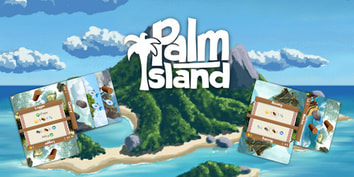 Image swiped from BGG Image swiped from BGG Kickstarter is never lacking in options for solo board games, and this week is no exception. There are two solo-playable board game campaigns that look particularly good at the moment: 1. Palm Island Palm Island is a game that is literally designed to be played in the palm of your hand. The art is tropically themed, but the name is also apt for the way you play it. No table necessary! It may have only 17 cards in a player deck, but you can manipulate them in a number of ways throughout the game to manage resources and develop your own village. In the solo game, feat cards add to the challenge of the game and keep things interesting. I'm excited about the possibilities of this one because of its portability and general cleverness. 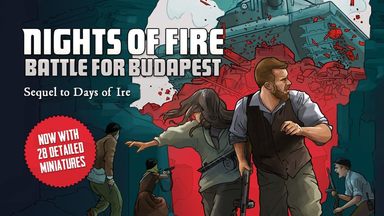 2. Nights of Fire: Battle for Budapest This game is a follow up to Days of Ire, which was very well received. In Nights of Fire, you can battle the Soviets solo, cooperatively, or against a live player who controls the enemy. The solo mode was designed by the maker of Anachrony's Chronobot, which means that single player games should feel more like playing against a live opponent and less like trying to beat your own score. Days of Ire and Nights of Fire can also be played in succession as part of an overarching campaign, if you're into that. I am definitely interested in this one because of its interesting theme and its promise as an excellent solo game. I wish I had more money! |
AuthorMy name is Liz Davidson, and I play solo board games. A lot of solo board games... Archives
August 2021
Categories
All
|
 RSS Feed
RSS Feed